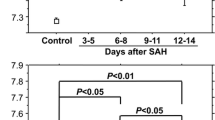Summary
In our in vitro study of subarachnoid haemorrhage, the anaerobic incubation of CSF-blood mixture led to marked fall in the pH value thereof, which suggested to us that intracranial focal acidosis may play some role in the pathogenesis of cerebral vasospasm or disturbance of consciousness after the haemorrhage. To test this hypothesis, we treated 16 clinical cases of such disorders with carotid injection of 7% sodium bicarbonate solution. The treatment resulted in considerable improvement of the disturbance of consciousness by dilating the cerebral peripheral arteries; this we could observe angiographically 15 minutes after carotid injection. We found no morphological changes, however, in the spastic vessel itself up to 30 minutes after the injection.
Given the result both of this study and of our previous experiments, we offer the hypothesis that the synthesizing process of thromboxane A 2 and intracranial focal acidosis might play an important role in the pathogenesis of cerebral vasospasm.
Similar content being viewed by others
References
Allen, G. S., Gross, C. J., French, L. A., Chou, S. N., Cerebral arterial spasm. Part 5: In vitro contractile activity of vasoactive agents including human CSF on human basilar and anterior cerebral arteries. J. Neurosurg.44 (1976), 594–600.
Allen, G. S., Henderson, L. M., Chou, S. N., French, L. A., Cerebral arterial spasm. Part 1: In vitro contractile activity of vasoactive agents on canine basilar and middle cerebral arteries. J. Neurosurg.40 (1974), 433–441.
Broersma, R. J., Bullemer, G. D., Mammen, E. F., Acidosis induced disseminated intravascular microthrombosis and its dissolution by streptokinase. Thromb. Diath. Haemorrh.24 (1970), 55–67.
Crowell, J. W., Houston, B., Effect of acidity on blood coagulation. Amer. J. Physiol.201 (1961), 379–382.
Ellis, E. F., Nies, A. S., Oates, J. A., Cerebral arterial smooth muscle contraction by thromboxane A2. Stroke8 (1977), 480–483.
Fletcher, T. M., Taveras, J. M., Pool, J. L., Cerebral vasospasm in angiography for intracranial aneurysms. Arch. Neurol.1 (1959), 38–47.
Foltz, E. L., Ward, A. A., Communicating hydrocephalus from subarachnoid bleeding. J. Neurosurg.13 (1956), 546–566.
Froman, C., Smith, A. C., Metabolic acidosis of the cerebrospinal fluid associated with subarachnoid haemorrhage. Lancet1 (1967), 965–967.
Hagen, A. A., Gerber, J. N., Sweeley, C. C., White, R. P., Robertson, J. T., Levels and disappearance of prostaglandin F2α in cerebral spinal fluid: A clinical and experimental study. Stroke8 (1977), 672–675.
Hardaway, R. M., Elovitz, M. J., Brewster, W. R., Houchin, D. N., Clotting time of hepalinized blood. Arch. Surg.89 (1964), 701–705.
Kapp, J. P., Robertson, J. T., White, R. P., Spasmogenic qualities of prostaglandin F2α in the cat. J. Neurosurg.44 (1976), 173–175.
Katsurada, K., Ogawa, M., Minami, T., Evaluation of CSF PO2 in management of the patients with acute head injury. I. CSF PO2 in relation to arterial PO2 and PCO2. Neurol. Surg. (Tokyo)1 (1973), 413–419.
LaTorre, E., Patrono, C., Fortuna, A. F., Grossi-Belloni, D., Role of prostaglandin F2α in human cerebral vasospasm. J. Neurosurg.41 (1974), 293–299.
Murphy, J. R., Erythrocyte metabolism. II. Glucose metabolism and pathways. J. Lab. Clin. Med.55 (1960), 286–302.
Ohnishi, H., Kosuzume, H., Yamaguchi, K., Suzuki, Y., Itoh, R., Experimental studies of trapidil on thromboxane A2 (TXA2)—induced aggregation of platelets, ischemic changes in heart and synthesis of TXA2. J. Jap. Atheroscler. Soc.7 (1979), 407–415.
Ohta, T., personal communication 1980.
Ohta, T., Bardwin, M., Experimental mechanical arterial stimulation at the circle of Willis. J. Neurosurg.28 (1968), 405–408.
Ohta, T., Waga, S., Handa, H., Saito, I., Takeuchi, H., Suzuki, J., Takaku, A., New grading of level of disordered consciousness. Neurol. Surg. (Tokyo)2 (1974), 623–627.
Osaka, K., Prolonged vasospasm produced by breakdown products of erythrocytes. J. Neurosurg.47 (1977), 403–411.
Pool, J. L., Cerebral vasospasm associated with ruptured intracranial aneurysms. Arch. Neurol.4 (1961), 208–210.
Reimondi, A. J., Torres, H., Acute hydrocephalus as a complication of subarachnoid hemorrhage. Surg. Neurol.1 (1973), 23–26.
Saito, I., Ueda, Y., Sano, K., Significance of vasospasm in the treatment of ruptured intracranial aneurysms. J. Neurosurg.47 (1977), 412–429.
Shannon, D. C., Shore, N., Kazemi, H., Acid-base balance in hemorrhagic cerebrospinal fluid. Neurology22 (1972), 585–589.
Suzuki, S., Experimental study of cerebral vasospasm—vasospasm of the circle of Willis. Brain Nerve (Tokyo)22 (1970), 393–403.
Suzuki, S., Ishii, M., Ottomo, M., Iwabuchi, T., Changes in the subarachnoid space after experimental subarachnoid haemorrhage in the dog: Scanning electron microscopic observation. Acta neurochir. (Wien)39 (1977), 1–14.
Suzuki, S., Suzuki, J., Cerebral vasospasm in cases of cerebral aneurysm—In association with recurrence of attack. Clin. Neurol. (Tokyo)14 (1974), 496–504.
Suzuki, S., White, R. P., Chapleau, C. E., Robertson, J. T., An experimental evaluation of anaerobic condition in the pathogenesis of cerebral vasospasm associated with subarachnoid hemorrhage. Hirosaki Med. J.32 (1980), 48–56.
Takahashi, S., Correlation of vasospasm and intracranial metabolism under experimental subarachnoid hemorrhage—Part 1. In reference with the acid-base-balance of cerebral blood and cerebrospinal fluid. Brain Nerve (Tokyo)30 (1978), 777–787.
White, R. P., Hagen, A. A., Morgan, H., Dawson, W. N., Robertson, J. T., Experimental study on the genesis of cerebral vasospasm. Stroke6 (1975), 52–57.
Wilkins, R. H., Levitt, P., Intracranial arterial spasm in the dog. A chronic experimental model. J. Neurosurg.33 (1970), 260–269.
Yamamoto, Y. L., Feindel, W., Wolfe, L. S., Katoh, H., Hodge, C. D., Experimental vasoconstriction of cerebral arteries by prostaglandins. J. Neurosurg.37 (1972), 385–397.
Author information
Authors and Affiliations
Rights and permissions
About this article
Cite this article
Suzuki, S., Sobata, E., Ando, A. et al. Anaerobic change of bloody CSF in subarachnoid haemorrhage. Its relation to cerebral vasospasm. Acta neurochir 58, 15–26 (1981). https://doi.org/10.1007/BF01401680
Issue Date:
DOI: https://doi.org/10.1007/BF01401680




